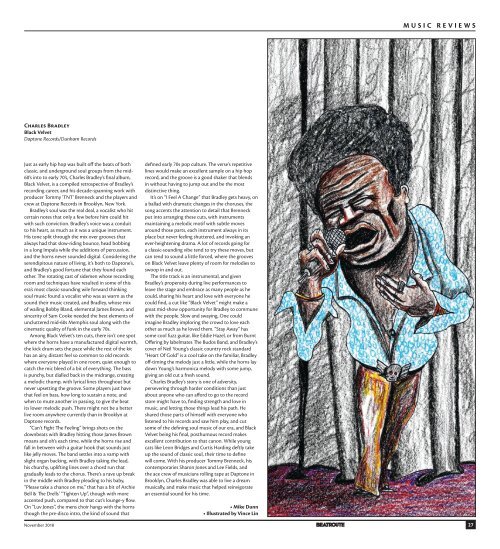BeatRoute Magazine BC Edition November 2018
BeatRoute Magazine is a monthly arts and entertainment paper with a predominant focus on music – local, independent or otherwise. The paper started in June 2004 and continues to provide a healthy dose of perversity while exercising rock ‘n’ roll ethics. Currently BeatRoute’s AB edition is distributed in Calgary, Edmonton (by S*A*R*G*E), Banff and Canmore. The BC edition is distributed in Vancouver, Victoria and Nanaimo. BeatRoute (AB) Mission PO 23045 Calgary, AB T2S 3A8 E. editor@beatroute.ca BeatRoute (BC) #202 – 2405 E Hastings Vancouver, BC V5K 1Y8 P. 778-888-1120
BeatRoute Magazine is a monthly arts and entertainment paper with a predominant focus on music – local, independent or otherwise. The paper started in June 2004 and continues to provide a healthy dose of perversity while exercising rock ‘n’ roll ethics.
Currently BeatRoute’s AB edition is distributed in Calgary, Edmonton (by S*A*R*G*E), Banff and Canmore. The BC edition is distributed in Vancouver, Victoria and Nanaimo. BeatRoute (AB) Mission PO 23045 Calgary, AB T2S 3A8 E. editor@beatroute.ca BeatRoute (BC) #202 – 2405 E Hastings Vancouver, BC V5K 1Y8 P. 778-888-1120
You also want an ePaper? Increase the reach of your titles
YUMPU automatically turns print PDFs into web optimized ePapers that Google loves.
MUSIC REVIEWS<br />
Charles Bradley<br />
Black Velvet<br />
Daptone Records/Dunham Records<br />
Just as early hip hop was built off the beats of both<br />
classic, and underground soul groups from the mid-<br />
60’s into to early 70’s, Charles Bradley’s final album,<br />
Black Velvet, is a compiled retrospective of Bradley’s<br />
recording career, and his decade-spanning work with<br />
producer Tommy ‘TNT’ Brenneck and the players and<br />
crew at Daptone Records in Brooklyn, New York.<br />
Bradley’s soul was the real deal, a vocalist who hit<br />
certain notes that only a few before him could hit<br />
with such conviction. Bradley’s voice was a conduit<br />
to his heart, as much as it was a unique instrument.<br />
His tone split through the mix over grooves that<br />
always had that slow-riding bounce, head bobbing<br />
in a long Impala while the additions of percussion,<br />
and the horns never sounded digital. Considering the<br />
serendipitous nature of living, it’s both to Daptone’s,<br />
and Bradley’s good fortune that they found each<br />
other. The rotating cast of sidemen whose recording<br />
room and techniques have resulted in some of this<br />
era’s most classic-sounding wile forward thinking<br />
soul music found a vocalist who was as warm as the<br />
sound their music created, and Bradley, whose mix<br />
of wailing Bobby Bland, elemental James Brown, and<br />
sincerity of Sam Cooke needed the best elements of<br />
uncluttered mid-60s Memphis soul along with the<br />
cinematic quality of funk in the early 70s.<br />
Among Black Velvet’s ten cuts, there isn’t one spot<br />
where the horns have a manufactured digital warmth,<br />
the kick drum sets the pace while the rest of the kit<br />
has an airy, distant feel so common to old records<br />
where everyone played in one room, quiet enough to<br />
catch the mic bleed of a bit of everything. The bass<br />
is punchy, but dialled back in the midrange, creating<br />
a melodic thump, with lyrical lines throughout but<br />
never upsetting the groove. Some players just have<br />
that feel on bass, how long to sustain a note, and<br />
when to mute another in passing, to give the beat<br />
its lower melodic push. There might not be a better<br />
live room anywhere currently than in Brooklyn at<br />
Daptone records.<br />
“Can’t Fight The Feeling” brings shots on the<br />
downbeats with Bradley hitting those James Brown<br />
moans and oh’s each time, while the horns rise and<br />
fall in between with a guitar hook that sounds just<br />
like jelly moves. The band settles into a vamp with<br />
slight organ backing, with Bradley taking the lead,<br />
his churchy, uplifting lines over a chord run that<br />
gradually leads to the chorus. There’s a rave up break<br />
in the middle with Bradley pleading to his baby,<br />
“Please take a chance on me,” that has a bit of Archie<br />
Bell & The Drells’ “Tighten Up”, though with more<br />
accented push, compared to that cut’s lounge-y flow.<br />
On “Luv Jones”, the mens choir hangs with the horns<br />
though the pre-disco intro, the kind of sound that<br />
defined early 70s pop culture. The verse’s repetitive<br />
lines would make an excellent sample on a hip hop<br />
record, and the groove is a good shaker that blends<br />
in without having to jump out and be the most<br />
distinctive thing.<br />
It’s on “I Feel A Change” that Bradley gets heavy, on<br />
a ballad with dramatic changes in the choruses, the<br />
song accents the attention to detail that Brenneck<br />
put into arranging these cuts, with instruments<br />
maintaining a melodic motif with subtle moves<br />
around those parts, each instrument always in its<br />
place but never feeling shuttered, and invoking an<br />
ever-heightening drama. A lot of records going for<br />
a classic-sounding vibe tend to try these moves, but<br />
can tend to sound a little forced, where the grooves<br />
on Black Velvet leave plenty of room for melodies to<br />
swoop in and out.<br />
The title track is an instrumental, and given<br />
Bradley’s propensity during live performances to<br />
leave the stage and embrace as many people as he<br />
could, sharing his heart and love with everyone he<br />
could find, a cut like “Black Velvet” might make a<br />
great mid-show opportunity for Bradley to commune<br />
with the people. Slow and swaying, One could<br />
imagine Bradley imploring the crowd to love each<br />
other as much as he loved them. “Stay Away” has<br />
some cool fuzz guitar, like Eddie Hazel, or from Burnt<br />
Offering by labelmates The Budos Band, and Bradley’s<br />
cover of Neil Young’s classic country rock standard<br />
“Heart Of Gold” is a cool take on the familiar, Bradley<br />
off-timing the melody just a little, while the horns lay<br />
down Young’s harmonica melody with some jump,<br />
giving an old cut a fresh sound.<br />
Charles Bradley’s story is one of adversity,<br />
persevering through harder conditions than just<br />
about anyone who can afford to go to the record<br />
store might have to, finding strength and love in<br />
music, and letting those things lead his path. He<br />
shared those parts of himself with everyone who<br />
listened to his records and saw him play, and cut<br />
some of the defining soul music of our era, and Black<br />
Velvet being his final, posthumous record makes<br />
excellent contribution to that canon. While young<br />
cats like Leon Bridges and Curtis Harding deftly take<br />
up the sound of classic soul, their time to define<br />
will come. With his producer Tommy Brenneck, his<br />
contemporaries Sharon Jones and Lee Fields, and<br />
the ace crew of musicians rolling tape at Daptone in<br />
Brooklyn, Charles Bradley was able to live a dream<br />
musically, and make music that helped reinvigorate<br />
an essential sound for his time.<br />
• Mike Dunn<br />
• Illustrated by Vince Lin<br />
<strong>November</strong> <strong>2018</strong> 27


















